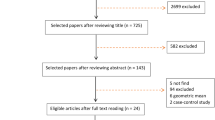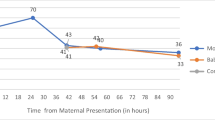Summary
It is well established that high levels of maternal lead exposure during pregnancy can result in a spectrum of adverse outcomes for the foetus, including spontaneous abortion, stillbirth, preterm delivery, and small-for-gestational-age deliveries. Less is known about lead-related intrauterine growth retardation at levels of lead exposure encountered by the general population. In an interim analysis of data from 202 inner-city infants, prenatal lead exposure was inversely related to birth weight and birth length. Maternal blood lead (PbB) concentrations ranged from 1 to 26 µg dl−1 \(\left( {\bar x = 7.6} \right)\). The lead effect varied from a negative 58 g per natural log unit increment in PbB for 18-year-old mothers to a negative 601 g per natural log unit increment in 30-year-old mothers.
Preview
Unable to display preview. Download preview PDF.
Similar content being viewed by others
References
Annest, J.L., Mahaffey, K.R., Cox, D.H. and Roberts, J. (1982). Blood lead levels for persons 6 months-74 years of age: United States, 1976–1980. Hyattsville, MD: U. S. Department of Health and Human Services; DHHS pub no. (PHS) 82–1250. (Advance data from vital and health statistics of the National Center for Health Statistics: no. 79 )
Ballard, J.L., Novak, K.K. and Driver, M. (1979). A simplified score for assessment of fetal maturation of newly born infants. J. Pediatr., 95, 766–774
Bellinger, D.C., Needleman, H.L., Leviton, A., Waternaux, C., Rabinowitz, M.B. and Nichols, M. (1984). Early sensory-motor development and prenatal exposure to lead. Neurobehav. Toxicol Teratol., 6, 387–402
Dietrich, K.N., Krafft, K.M., Shukla, R., Bornschein, R.L. and Succop, P.S. (1987). The neurobehavioral effects of prenatal and early postnatal lead exposure. AAMD Monograph: Mental Retardation, Neurobehavioral Toxicology and Teratology, 8, 71–95
Ernhart, C.B., Wolf, A.W., Kennard, M.J., Erhard, P., Filipovich, H.F. and Sokol, R.J. (1986). Intrauterine exposure to low levels of lead: the status of the neonate. Arch. Environ. Health, 41, 287–291
Hobel, C.J., Youkeles, L. and Forsythe, A. (1979). Prenatal and intrapartum high-risk screening: II. Risk factors reassessed. Am. J. Obstet. Gynecol., 135, 1051–1056
Hollingshead, A.B. (1975). Four Factor Index of Social Status. Unpublished manual. ( New Haven, Connecticut )
Khera, A.K., Wibberly, D.G. and Dathan, J.G. (1980). Placental and stillbirth tissue lead concentrations in occupational exposed women. Br. J. Ind. Med., 37, 394–396
Lane, R.E. (1949). The care of the lead worker. Br.J. Ind. Med., 6, 125-143
Littman, B. and Parmelee, A.H. (1978). Medical correlates of infant development. Pediatrics, 61, 470–474
McMichael, A.J., Vimpani, G.V., Robertson, E.F., Baghurst, P.A. and Clark, P.D. (1986). The Port Pirie cohort study: maternal blood lead and pregnancy outcome. J. Epidemiol Community Health, 40, 18–25
Needleman, H.L., Rabinowitz, M., Leviton, A., Linn, S. and Schoenbaum, S. (1984). The relationship between prenatal exposure to lead and congenital anomalies. J. Am. Med. Assoc., 251, 2956–2959
Oliver, T. (1911). Lead poisoning and the race. Br. Med. J., 1 (2628), 1096–1098
Rom, W.N. (1976). Effects of lead on the female and reproduction: a review. Mount Sinai J. Med., 43, 542–552
Wibberly, D.G., Khera, A.K., Edwards, J.H. and Rushton, D.I. (1977). Lead levels in human placenta from normal and malformed births. J. Med. Genet., 14, 339–345
Editor information
Editors and Affiliations
Rights and permissions
Copyright information
© 1989 ECSC-EEC-EAEC, Brussels — Luxembourg; EPA, USA
About this chapter
Cite this chapter
Bornschein, R.L. et al. (1989). Effects of Prenatal Lead Exposure on Infant Size at Birth. In: Smith, M.A., Grant, L.D., Sors, A.I. (eds) Lead Exposure and Child Development. Springer, Dordrecht. https://doi.org/10.1007/978-94-009-0847-5_18
Download citation
DOI: https://doi.org/10.1007/978-94-009-0847-5_18
Publisher Name: Springer, Dordrecht
Print ISBN: 978-94-010-6868-0
Online ISBN: 978-94-009-0847-5
eBook Packages: Springer Book Archive




